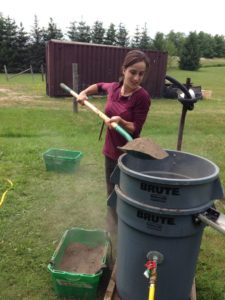Good day friends. Thanks for joining us as we conclude our posts on Patterson Village. For this, we’ll  discuss how we collect preserved plant remains from sites such as Patterson Village. When we dig cellars, pit privies, and box privies, we collect soil samples for processing using a technique called flotation. For the privies, we took samples from areas where there were lenses of raspberry seeds, which I now believe were a by-product of making raspberry cordial or jelly. In making these
discuss how we collect preserved plant remains from sites such as Patterson Village. When we dig cellars, pit privies, and box privies, we collect soil samples for processing using a technique called flotation. For the privies, we took samples from areas where there were lenses of raspberry seeds, which I now believe were a by-product of making raspberry cordial or jelly. In making these  fruit products, the raspberries would have been wrapped in a piece of fabric and then squeezed to extract the juice. The remaining mash was usually deposited in privies to prevent the attraction of flies.
fruit products, the raspberries would have been wrapped in a piece of fabric and then squeezed to extract the juice. The remaining mash was usually deposited in privies to prevent the attraction of flies.
Next, we transported our soil samples back to the laboratory where we have a flotation machine. The soil sample is placed in the machine that is filled with water which also has fresh water flowing into it. This causes the preserved plant remains to float to the surface; then they’re drained off into a fine screen.
For our final report on the Patterson Village project, we sent 24 samples from 9 cellars, 35 samples from 17 pit privies, and 16 samples from box privies to Rudy Fecteau; his specialty is identifying the seeds and charcoal recovered from these samples. Rudy reported that he identified 704,356 seeds including 696,493 raspberry seeds, 5,325 choke cherry pits, 973 elderberry seeds, 810 grape seeds, and nine goosefoot seeds. Now that’s a lot of seeds! Of particular interest was the fact that the box privies produced their greatest numbers of raspberry seeds, a result that still baffles. 
The grape seeds are quite interesting because, in 1859, Peter Patterson on seven separate dates advertised in The York Herald that he had grape roots for sale at 50 cents each. Again, I have to thank Ruth Redelmeier for bringing these ads to my attention. This provides yet another link between the historical documents and the archaeological finds relating to a matter which is not well known.
Rudy also brought to light charcoal from pine in one of the cellars and some of the privies. When Peter Patterson purchased the lot to construct his factory and village, the land was covered with white pine; a relic of the Huron-Wendat corn fields which occupied the lot in the 16th century.
I continue to be amazed with the unique types and vast amounts of plant remains which are preserved in the archaeological record. Remember, we can uncover anything if we use the right tools to collect them.
I hope you’ve enjoyed our Patterson Village series. If you know someone else who would appreciate this blog, feel free to like and share on social media. You can purchase the book via the I C bookstore in paperback or iBook.
Kindest regards,
Bill Finlayson
William D. Finlayson, Midland, Ontario
Ontario’s Leading and Senior-Most Archaeologist and Author
